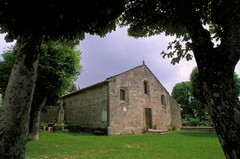Municipality of Pavullo.
The story continues just a short distance from the Castle of Montecuccolo: the villages of Renno, Montebonello and Olina
Renno
After leaving the Castle of Montecuccolo it is worthwhile dedicating a visit to the small neighbouring villages which retain some fascinating ancient monuments. The closest is Renno, just a short pleasant stroll away.
This place was first mentioned in a document from 890 kept in the Nonantola Abbey archives. At that time Renno was most likely the administrative, tax and judiciary centre of Frignano, not far from the defensive system of the Castrum feronianum, a Byzantine defence system, which it was in visual contact with via the Renno di Sopra castle, which is now reduced to just a few ruins.
Renno too was the site of fierce struggles and battles between the Guelph and Ghibelline factions which bloodied central Frignano during the Middle Ages.
From a historical and artistic point of view, Renno is important for its small peaceful parish church, dedicated to Saint John the Baptist. When it was built remains uncertain; according to certain scholars it was in 1157, while for others it was much later, around the 8th – 9th century.
Altered several times over the centuries, it features a pitched-roof façade into which three large windows were inserted sometime in the 1600 to 1700s, while in 1792, the entrance portal was widened. Other windows were opened in the side and the southern apse, while the two minor apses beside the surviving central one were blocked up. The two side chapels do not belong to the original building and the belltower was erected in 1705.
The interior of the church is divided into three naves held aloft by somewhat particular pillars of a rare and unusual shape, with one in particular ‒ the first column on the right ‒bearing a carved Chi Rho, the monogram of Christ, similar to those in the church of Saint-Avit in Orleans, France. This mark, obtained by superimposing the Greek initials for Christ, is an ancient symbol of faith in Jesus and appears frequently in Byzantine, Lombard and Romanesque art.
The church is home to some interesting works of art including a sixteenth-century fresco depicting the Baptism of Jesus on the central pillar on the right, and a charming holy water stoup in red marble from Verona. Tradition has it that this was donated by the Marquise Anna Bigi on the occasion of the birth of her son, Raimondo Montecuccoli, in 1609.
Recent restoration work has brought to light eight crosses on the walls of the central nave, each inserted in a circle decorated with small garlands of leaves, as testimony of the consecration of the building.
In the right-hand nave is a chapel containing the sepulchre of the Montecuccoli, including the tomb of the mighty Cesare I who died in 1506.
Montebonello
One of the most important villages near Pavullo is Montebonello, where we can still be struck by an ancient medieval atmosphere.
Montebonello was mentioned in 1033 in a document in which the Bishop of Modena donated the castle to Boniface of Tuscany, the father of Matilda of Canossa. Over the centuries, it belonged to various feudal families, in particular the Montegarullo, sworn enemies of the Montecuccoli. In 1408 it was definitively subjugated by the Este family and added to the Podesteria of Monfestino.
In the centre of this small village nestling among rolling hills, sits the Natività di Maria church, originally built as a chapel for the first castle. Rebuilt in the 12th century and altered in the centuries to come, it features artistic elements of remarkable interest. On the side that faces onto the small piazza can be seen, walled into the portico, an octagonal column and fragments of capitals which recall those of Renno. Of note are the two portals, one Gothic and the other Romanesque, above which a Gordian knot is carved. The four twin lancet windows cut into a single sandstone ashlar are unique in the whole of the Modena Apennine.
Inside, what immediately catches the eye is the splendid rounded arch above the presbytery and, on the walls, fifteenth-century frescoes of a rare sophistication, depicting scenes from the lives of the Saints and the Madonna, discovered during a 1978 restoration.
Olina
Between Renno and Montecenere it is worthwhile visiting the village of Olina, mentioned under the name of Aulina in a 1276 dedication, and in the act with which Gaspare Montecuccoli surrendered himself and his castles to Marquis Nicolò III d'Este.
The year 1269 saw a cruel battle between Guelphs and Ghibellines in these parts, which ended in a crushing defeat for the Montecuccoli, during the bitter struggle against the Gualandelli for control of Frignano. The tyrannical regime imposed at this point by the Montecuccoli feudatories aroused much bad feeling amongst the local populace and sparked off some heartfelt rebellions. Despite this Olina remained a subject of the noble house until the 1700s.
Of remarkable interest here is the bridge over the Scoltenna stream. Built out of stone, with a single arch featuring light parabolic lines, it was built in 1522 on top of the ruins of an earlier, much older one, conceivably dating back to Roman times. In view of its strategic importance for the passage of both goods and people, the Montecuccoli invested 200 gold scudi to have it rebuilt. Others who contributed to this important work were the Podesteria of Sestola and the Communes of Florence and Lucca.
Over time the bridge underwent refinement and restoration, without losing its great fascination.
A rather sinister old legend, which harks back to a tragic event that occurred in 1400, tells that anyone crossing the bridge on a dark stormy night will hear a strangled breathless voice pleading for help.
